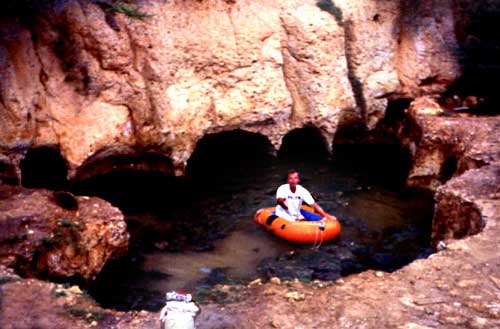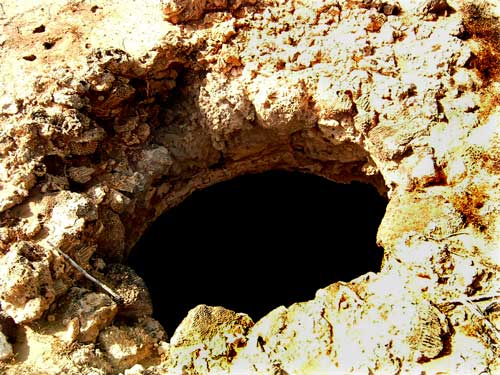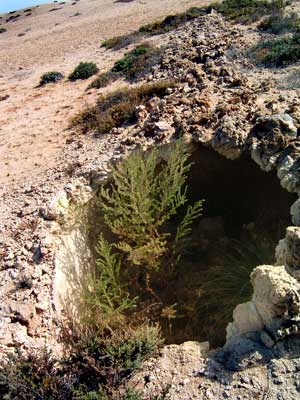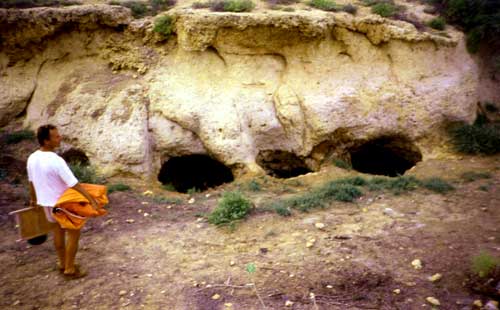The First ‘Re-Discovery’ In mid-November 1988, while I was in Nice, France, I received a phone call from my good friend Pascal d’Ursel asking me to join him on his sailboat at Suez for a trip down the Red sea and the Indian Ocean to Kenya. I grabbed a few books and my girlfriend and four days later we were sailing south, admiring under the spinnaker the majestic mountains of the Sinai taking fire at sunset. The 42-foot sailboat had a retractable keel and was equipped with the first SatNav device allowing us to have a precise position every six hours, a must at the time, which gave us the confidence to risk coastal navigation. We were in no rush and decided to stop and visit as many creeks and islands along the African coast as we could. Red-Sea
Cisterns This was a place to visit! And in fact, when we stepped on this
island, what we saw was worth the tricky navigation to get there. It
is a whole complex of cisterns, caves, bathtubs, excavations and
galleries carved into the limestone rock, containing hundred of
cubic meters of fresh water. It immediately brought to mind some
Pharaoh of the past and the hundreds of workers needed to achieve
this complex. It also told me that the Ancients of this place had a
pretty good knowledge of water-management. We spent a few days here
taking baths in the cool caves and washing clothes at the cisterns.
I took a few photos and did not pay attention to a few ruined houses
marked on the charts as “ruins of a fishing village.” Greek and Roman Ruins in
the Sudan
Searching for Ptolomaic-Roman settlements I could not visit all the positions that I wanted
to along the African coast of the Red sea, but the first photos of
these unknown places that I brought back are gathering the interest
of several scientists from France, USA, Great Britain, Italy and
Brazil. We now form a complete team looking to go back sailing in
the Red sea to scientifically identify and date the occupation of
the sites I have visited before, and discover what the coastal
ruins, spotted on satellite imagery, exactly are. We expect to
confirm the locations of the Ptolemaic-Roman settlements known only
through literature, and the two oldest fish-farm complexes from
Pharaonic time. |
Therm found in 1988. We bathed and washed clothes in this pond which gives access to several bath rooms. It seems that the whole place was once completely underground and collapsed.
Ancient bath tub: note the marks of the tool used to carve the limestone. The Roman Therms Much More than Hot Water Therms (or thermes and thermae) are Roman baths and you can find the ruins of Roman bath houses all over Europe. These baths were heated via a hollow floor called a hypocaust, through which hot air was forced to rooms called the Caldarium and Tepidarium. There was also a Frigidarium featuring a cold plunge-bath. Roman therms had a social function which we moderns find it difficult to appreciate. First of all, they were frequented by absolutely everyone, even the slaves and the very poor. According to Wikipedia, in the baths you could "exercise, read, drink, shop, socialize and discuss politics. The modern equivalent would be a combination of a library, art gallery, mall, bar/restaurant, gym and spa."
Point of entry for rain water, at ground level, into the underground cistern.
Cave found on a Red Sea island. The water inside is fresh and cool while it’s 35° Celsius outside. The literature says that “Julian, sent by Justinian to Nobatia in about 542 was suffering from the heat and used to take baths during the day in caverns filled with water, undressed, like the natives."
Several entrances to underground cisterns on the same island (see above).
Cave One. This may look like a natural cave, but it's not. See the following picture.
Inside Cave One there is a large room of 10 X 2.4 meters with an opening on the roof, note the square shape of the walls instead of an arch. The walls and roof are plastered with a mixture of clay and coral powder that seems to have been baked on the spot.
Red Sea Therms: Pascal d’Ursel in 1988. Openings give light and ventilation to an underground gallery with bath rooms. |








 Michel Pons is now organizing a new expedition to the Red Sea. If you are
interested, or if you know of a group or individual that might want to support
such a project, see
Michel Pons is now organizing a new expedition to the Red Sea. If you are
interested, or if you know of a group or individual that might want to support
such a project, see